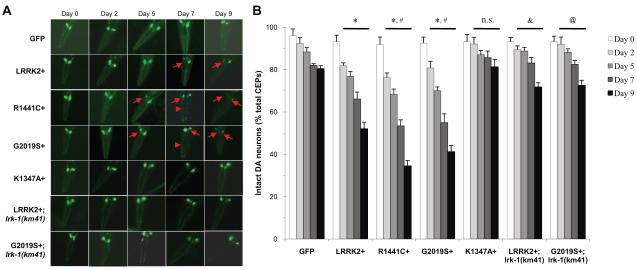Fig. 2.
LRRK2 expression leads to DA neurodegeneration. (A) C. elegans expressing GFP marker contained intact DA neurons (CEP neurons) and smooth neurites, whereas the C. elegans LRRK2 overexpression lines (LRRK2+, R1441C+ and G2019S+) displayed prominent loss of DA neurons (arrows) and broken neuritis (arrowheads) during adulthood. Days in adulthood (number of days past larval stage L4) is indicated on top. (B) The age-dependent DA neurodegeneration was quantified by the loss of CEP neurons in transgenic animals with different ages. Synchronized worms at adult day 0 (L4 larval stage), 2, 5, 7, and 9 were mounted on agar-containing slides for live imaging and scoring for the presence of each of the four CEP neurons visualized by GFP fluorescence. About 20-30 animals per strain were used in each of the three to four independent experiments. The total number of CEP neurons expected from all animals (4 per animal) is regarded as 100%, and numbers of CEP neurons detected in each experiment are used to calculate the percent intact DA neurons remaining. LRRK2+ and G2019S+ worms were crossed with the lrk-1(km41) mutant worms to generate the LRRK2+; lrk-1(km41) and G2019S+; lrk-1(km41) strains, respectively. Error bars indicate SEM. One-way ANOVA: * p<0.01 versus GFP control. # p<0.05 versus LRRK2+. & p<0.01 versus LRRK2+. @ p<0.01 versus G2019S. n.s., not significant compared to GFP reporter line.

